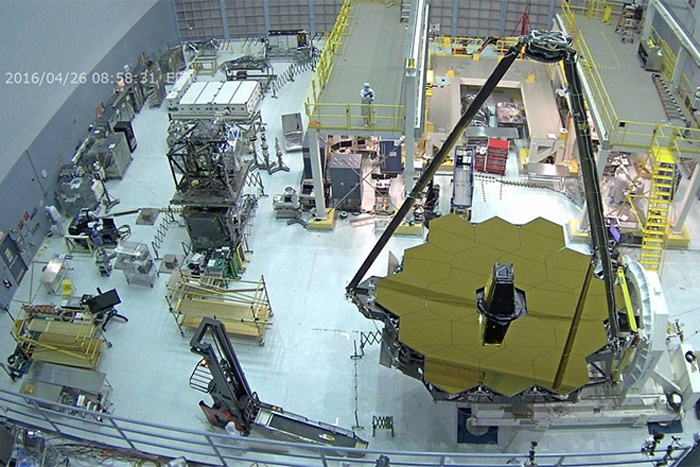Say Hello to Our Future Mega-Space Telescope

The Hubble Space Telescope has revolutionized our view of the universe in the 26 years since it was launched in 1990. Though it is showing few signs of slowing down, since NASA retired its space shuttle fleet in 2011, the most powerful space telescope in history is now by itself, with no further servicing missions to extend its lifespan. In short, if something goes wrong, the veteran mission cannot be repaired and we'll lose our powerful eye on the cosmos.
Though the joint NASA/ESA mission is undoubtedly in its twilight years, there's a bigger cousin in the works that will take over when Hubble's mission ends. And as can be seen from the above view from a cleanroom at NASA's Goddard Space Flight Center in Maryland, the James Webb Space Telescope (JWST) is a beauty.
PHOTOS: NASA's Next-Generation Telescope: Ace Comet Hunter?
The JWST will be the most powerful space telescope ever to be launched. Looking at wavelengths "beyond" Hubble's capabilities, the joint NASA, ESA, Canadian Space Agency and Space Telescope Science Institute mission will observe the universe in infrared light, opening a previously unseen look at the first galaxies to form at the beginning of time. Infrared light passes through even the most optically opaque molecular clouds, allowing us an incredibly high resolution and intimate look into star-forming regions. Though JWST won't "replace" Hubble, as it won't access the optical and ultraviolet wavelengths Hubble sees so well, it will see further back in time and give us a revolutionary view of the infrared cosmos.
Composed of 18 hexagonal gold-coated beryllium mirrors, collectively spanning 6.5 meters (over 21 ft), JWST will dwarf Hubble's 2.4 meter (7.9 ft) diameter mirror, giving the JWST 7 times the light-collecting power. Where Hubble is "school bus-sized," JWST's bulk will be "tennis court-sized" and will therefore need an unconventional method to be launched into space.
PHOTOS: The JWST's Mind-Blowing Science Potential
Whereas Hubble was released into Earth orbit by space shuttle Discovery on April 25, 1990, JWST will be launched well beyond the orbit of the moon to an island of gravitational stability, some 1.5 million miles "behind" the Earth and away from the sun called a Lagrangian Point (specifically, the Earth-sun L2 point). As any infrared telescope needs to be kept as cool as possible, JWST has a huge solar shield and sophisticated radiator system that will keep the telescope and instrumentation close to an operating temperature of below 50 Kelvin (−220 degrees Celsius; −370 degrees Fahrenheit). As it's so big, JWST can't be launched in its operational configuration; it will launch folded and, on reaching its destination, it will unfurl in a complex origami-like way.
Get the Space.com Newsletter
Breaking space news, the latest updates on rocket launches, skywatching events and more!
As shown by a series of cleanroom photos on the official JWST Twitter account, work is currently underway to attach the telescope's instrumentation to the rear of the spacecraft. Over the last few months, each hexagonal mirror has been attached to the telescope's frame, but each had a protective cover. To install the instrumentation, the whole spacecraft needs to be turned upside-down, so these covers first needed to be removed. We can now see how the actual JWST's telescope will look when it unpacks itself in space to begin operations in 2018.
PHOTO: Hubble Spies 26th Birthday Bubble Beauty
In an interview with BBC News, European Space Agency's JWST project scientist, Pierre Ferruit addressed any concerns about the possibility of damage to the extremely delicate golden mirrors.
"The main danger is to get some accumulation of dust," he said. "But it's a cleanroom so that accumulation is very slow.
"They need to rotate the telescope to get access to the back, and the protective covers were only resting on the mirror segments, so they had to be removed before the rotation. When the mirror is upside down, the exposure to dust will be much less, and I doubt anyone will be allowed to walk underneath."
Once the instrumentation is attached to the mirrors, JWST will be exposed to vibration and cryo testing to simulate the rigors of launch and the extreme environment of space. Once this is complete over the next few months, the whole lot will be installed on the spacecraft "bus" which includes the mission's communications systems, flight computers and large solar shield.
The mission is targeted for launch in October 2018 on board a European Arianne rocket. On completion, it is estimated that the JWST partners will have spent $10 billion on the project.
Originally published on Discovery News.
Join our Space Forums to keep talking space on the latest missions, night sky and more! And if you have a news tip, correction or comment, let us know at: community@space.com.
Ian O'Neill is a media relations specialist at NASA's Jet Propulsion Laboratory (JPL) in Southern California. Prior to joining JPL, he served as editor for the Astronomical Society of the Pacific‘s Mercury magazine and Mercury Online and contributed articles to a number of other publications, including Space.com, Space.com, Live Science, HISTORY.com, Scientific American. Ian holds a Ph.D in solar physics and a master's degree in planetary and space physics.









